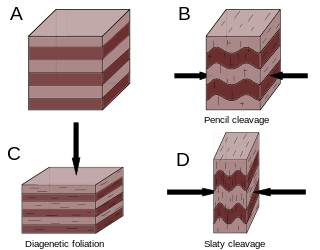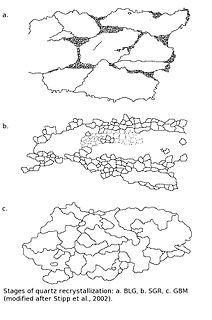This page is based on this
Wikipedia article Text is available under the
CC BY-SA 4.0 license; additional terms may apply.
Images, videos and audio are available under their respective licenses.

Metamorphic rocks arise from the transformation of existing rock types, in a process called metamorphism, which means "change in form". The original rock (protolith) is subjected to heat and pressure, causing profound physical or chemical change. The protolith may be a sedimentary, igneous, or existing metamorphic rock.

A seed crystal is a small piece of single crystal or polycrystal material from which a large crystal of typically the same material is to be grown in a laboratory. Used to replicate material, the use of seed crystal to promote growth avoids the otherwise slow randomness of natural crystal growth and allows manufacture on a scale suitable for industry.
Dynamic recrystallization (DRX) is a type of recrystallization process, found within the fields of metallurgy and geology. In dynamic recrystallization, as opposed to static recrystallization, the nucleation and growth of new grains occurs during deformation rather than afterwards as part of a separate heat treatment.

The iron meteorites of the IIE chemical type are octahedrites of various coarseness, most of which contain numerous inclusions of recrystallized stony silicates.
Working generally refers to employment. It may also refer to:
Annealing, in metallurgy and materials science, is a heat treatment that alters the physical and sometimes chemical properties of a material to increase its ductility and reduce its hardness, making it more workable. It involves heating a material above its recrystallization temperature, maintaining a suitable temperature for a suitable amount of time, and then cooling.
Geometric Dynamic Recrystallization (GDR) is a recrystallization mechanism that has been proposed to occur in several alloys, particularly aluminium, at high temperatures and low strain rates. It is a variant of dynamic recrystallization.
In metallurgy, materials science and structural geology, subgrain rotation recrystallization is recognized as an important mechanism for dynamic recrystallisation. It involves the rotation of initially low-angle sub-grain boundaries until the mismatch between the crystal lattices across the boundary is sufficient for them to be regarded as grain boundaries. This mechanism has been recognized in many minerals and in metals.

In chemistry, work-up refers to the series of manipulations required to isolate and purify the product(s) of a chemical reaction.

Cleavage, in structural geology and petrology, describes a type of planar rock feature that develops as a result of deformation and metamorphism. The degree of deformation and metamorphism along with rock type determines the kind of cleavage feature that develops. Generally these structures are formed in fine grained rocks composed of minerals affected by pressure solution.
Neomorphism refers to the wet metamorphic process in which diagenetic alterations systematically transform minerals into either polymorphs or crystalline structures that are structurally identical to the rock(s) from which they developed.
In structural geology, metallurgy and materials science, deformation mechanisms refer to the various mechanisms at the grain scale that are responsible for accommodating large plastic strains in rocks, metals and other materials.

Hot working process metals are plastically deformed above their recrystallization temperature. Being above the recrystallization temperature allows the material to recrystallize during deformation. This is important because recrystallization keeps the materials from strain hardening, which ultimately keeps the yield strength and hardness low and ductility high. This contrasts with cold working.

Primitive achondrites are a subdivision of meteorites. They are classified on the same rank and lying between chondrites and achondrites. They are called primitive because they are achondrites that have retained much of their original chondritic properties. Very characteristic are relic chondrules and chemical compositions close to the composition of chondrites. These observations are explained as melt residues, partial melting, or extensive recrystallization.

Quartz is the most abundant single mineral in the earth's crust, and as such is present in a very large proportion of rocks both as primary crystals and as detrital grains in sedimentary and metamorphic rocks. Dynamic recrystallization is a process of crystal regrowth under conditions of stress and elevated temperature, commonly applied in the fields of metallurgy and materials science. Dynamic quartz recrystallization happens in a relatively predictable way with relation to temperature, and given its abundance quartz recrystallization can be used to easily determine relative temperature profiles, for example in orogenic belts or near intrusions.

Dibromine pentoxide is the chemical compound composed of bromine and oxygen with the formula Br2O5. It is a colorless solid that is stable below −20 °C. It has the structure O2Br−O−BrO2, the Br−O−Br bond is bent with bond angle 121.2°. Each BrO3 group is pyramidal with the bromine atom at the apex.

Octamethylene-bis(5-dimethylcarbamoxyisoquinolinium bromide) is an extremely potent carbamate nerve agent. It works by inhibiting the acetylcholinesterase, causing acetylcholine to accumulate. Since the agent molecule is positively charged, it does not cross the blood brain barrier very well.











